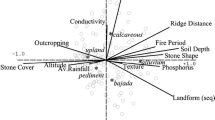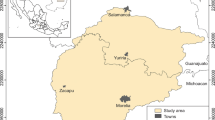Abstract
Transects of contiguous one square meter quadrats were sampled across the marl and peat mosaic of the Byron-Bergen swamp, a rich fen in western New York. The data were analyzed by detrended correspondence analysis (DCA).
Ordination of species and samples produced arrangements reflecting a complex environmental gradient of hydrology, soil organic matter and soil carbonate-carbon concentration. They successfully separated fens underlain with peat from those underlain with marl and showed a physiognomic gradient associated with hummock development.
This research was supported in part by National Science Foundation Grant DEB-7809340 to R. H. Whittaker, especially an amendment to support John M. Bernard under NSF Support for Small College Faculty through Grants at Large Institutions program.
The Bergen Swamp Preservation Society, Inc. allowed us to sample on their property.
Similar content being viewed by others
References
Allison, L. E., 1965. Organic carbon. In: Black et al. (eds.). Methods of Soil Analysis. Amer. Soc. of Agronomy, Inc., Madison, Wisc.
Broadbent, F. E., 1965. Organic matter. In: Black et al. (eds.). Methods in Soil Analysis. Amer. Soc. of Agronomy, Inc., Madison, Wisc.
Brown, B. I., 1948. The vegetation of Bergen Swamp II. The epiphytic plants. Proc. Roch. Acad. Sci. 9: 119–130.
Chapman, H. D., 1965. Cation-exchange capacity. In: Black et al. (eds.). Methods in Soil Analysis. Amer. Soc. of Agronomy, Inc., Madison, Wisc.
Crum, H. & Anderson, L. E., 1981. Mosses of Eastern Norh America. Columbia Univ. Press, N. Y. 1328 pp.
Fairchild, H. L., 1928. Geologic Story of the Genesee Valley and Western New York. Rochester, N. Y. 125 pp.
Fernald, M. L., 1950. Gray's manual of Botany, 8th ed. American Bk Co, N. Y. 1632 pp.
Gauch, H. G., 1982. Multivariate Analysis in Community Ecology. Cambridge University Press, Cambridge.
Heinselman, M. L., 1970. Landscape evolution, peatland types and the environment in the Lake Agassiz Peatlands Natural Area. Ecol. Monogr. 40: 235–261.
Hill, M. O., 1979. DECORANA A FORTRAN program for detrended correspondence analysis and reciprocal averaging. Cornell Ecology Programs, Ecology and Systematics. Cornell University, Ithaca, N. Y. 52 pp.
Hill, M. O. & Gauch, H. G., 1980. Detrended correspondence analysis, an improved ordination technique. Vegetatio 42: 47–58.
Hotchkiss, A. T., 1950. The vegetation of Bergen Swamp IV. The algae. Proc. Roch. Acad. Sci. 9: 237–266.
Muenscher, W. C., 1946. The vegetation of Bergen Swamp I. The vascular plants. Proc. Roch. Acad. Sci. 9: 64–117.
Muenscher, W. C., 1948. The vegetation of Bergen Swamp III. The myxomycetes. Proc. Roch. Acad. Sci. 9: 131–137.
Peech, M., 1965. Hydrogen ion activity. In: Black et al. (eds.). Methods in Soil Analysis. Amer. Soc. of Agronomy, Inc., Madison, Wisc.
Rogerson, C. T. & Muenscher, W. C., 1950. The vegetation of Bergen Swamp. VI. The fungi. Proc. Roch. Acad. Sci. 9: 277–314.
Seischab, F. K., 1977. Plant community development in the Byron-Bergen Swamp: A rheotrophic mire in Genesee County, N.Y. Ph.D. Thesis, State Univ. Col. of Environmental Science & Forestry, Syracuse, N.Y. Univ. Microfilms Int. Publ. No.: 78: 6183.
Shmida, A. & Whittaker, R. H., 1981. Pattern and biological microsite effects in two shrub communities, southern California. Ecology 62: 234–251.
Stewart, P. A. & Merrell, W. D., 1937. The Bergen Swamp: An ecological study. Proc. Roch. Acad. Sci. 7: 209–262.
Walker, R. S., 1974. The vascular plants and ecological factors along a transect in the Bergen-Byron Swamp. Proc. Roch. Acad. Sci. 12: 241–270.
Whittaker, R. H., Gilbert, L. E. & Connell, H. H., 1979. Analysis of two-phase pattern in a mesquite grassland, Texas. J. Ecol. 67: 935–952.
Whittaker, R. H. & Naveh, Z., 1979. Analysis of two-phase patterns. In: Patil, G. P. & Rosenzweig, M. (eds.). Contemporary Quantitative Ecology and Related Ecometrics, pp. 157–165. Statistical Ecology, Vol. 12. Internat. Coop. Publ. House, Fairland, Maryland.
Whittaker, R. H., Niering, W. A. & Crisp, M. D., 1979. Structure, pattern and diversity of a mallee community in New South Wales. Vegetatio 39: 65–76.
Winne, W. T., 1950. The vegetation of Bergen Swamp VII. The Bryophytes. Proc. Roch. Acad. Sci. 9: 315–326.
Author information
Authors and Affiliations
Additional information
Vascular plant nomenclature follows Fernald (1950). Bryophyte nomenclature follows Crum & Anderson (1981).
Two decades of research in ordination and classification by Robert Whittaker was seen by him as a prelude to the study of pattern within communities. We acknowledge Whittaker's leadership in this field, and his contribution to the research presented here.
Rights and permissions
About this article
Cite this article
Bernard, J.M., Seischab, F.K. & Gauch, H.G. Gradient analysis of the vegetation of the Byron-Bergen swamp, a rich fen in western New York. Vegetatio 53, 85–91 (1983). https://doi.org/10.1007/BF00043026
Accepted:
Issue Date:
DOI: https://doi.org/10.1007/BF00043026




